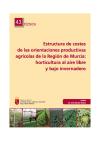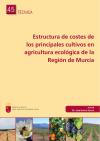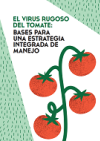Media library
Documentary, graphic and/or audiovisual knowledge objects are offered here, offering information on various sectors and topics. Use the keyword search or search filters to access current audiovisual and documentary knowledge objects useful for your implementation.
If you have any questions or suggestions, please contact us here.

Phytosanitary strategies in tomato
Strategies for the use of phytosanitary products in tomte cultivation

Cost structure of the agricultural production guidelines of the Region of Murcia: nuts, pome fruit, vines, and olives
Publication dedicated to the most characteristic woody crops of rural Murcia, including nuts, pome fruit, table and wine grapes, and olive trees.

Cost structure of agricultural production areas in the Region of Murcia: open-air and greenhouse horticulture
Publication dedicated to regional horticultural crops, both outdoors and under protected and greenhouse conditions.

Cost structure of the main crops in organic farming in the Region of Murcia
Document describing the main guidelines for regional organic farming in Murcia

Tomato rugose virus: bases for an integrated management strategy
Document with information on epidemiological aspects—such as plant infection, virus spread, alternative hosts, virus persistence in the environment, etc.—that are essential for understanding and framing.

How to assess the quality of your soil. Visual soil assessment in olive groves
Guide that guides allows to estimate the visual evaluation of the soil (EVS) through a quick and simple method to estimate the condition of the soil, the suitability, quality and limitations that a soil presents for the olive grove
Procedure for uprooting olive plantations for ornamental purposes in the Autonomous Community of Aragon
Information on the uprooting of olive tree plantations for ornamental purposes in the Autonomous Community of Aragon
Plant pest and disease advisories, beware of the possible introduction or presence of Tomato Rugose Fruit Virus (ToBRFV)
Organism under community emergency measures that causes symptoms on leaves and damage to tomato fruits
Plant pest and disease alerts: Presence of a large number of individuals of Mythimna unipuncta, a grass defoliating caterpillar.
A very voracious and polyphagous defoliating caterpillar that can affect both forage and horticultural crops, with prairies and grasslands, along with corn, being the most affected.
Plant Pest and Disease Advisories: Guatemalan Potato Moth Tecia solanivora
Tecia solanivora is considered a quarantine organism due to the potential phytosanitary risk it represents, constituting a serious threat to potato production by affecting and rendering tubers worthless, either during cultivation or in storage.
Notice of the first outbreak of Tomato Rugose Fruit Virus (ToBRFV) in the Region of Murcia (September 27, 2021)
Tomato brown rugose fruit virus (ToBRFV), a member of the tobamovirus family, was first detected in tomato crops in Israel in 2014 and in Europe in Germany in 2018. In 2019, it experienced a significant expansion when it was isolated in Italy, the Netherlands, Greece, and other Member States.
Olive fly (Bactrocera oleae) treatment notice
The olive fruit fly population is beginning to increase this year, so an initial bait treatment is recommended. Once the first pitted olives appear, the next generation of adults will emerge approximately 25 days later, and a second bait treatment is required to control them.
Monitoring the olive fruit fly (Bactrocera oleae)
Field Pest Situation Report, 2024 Campaign, Week 43: October 21-October 27
Technical information on the potato flea beetle (Epitrixs pp.)
The potato flea beetle refers to several species of the Epitrix genus, which are primarily considered pests of potato crops, although they can also affect other Solanaceae crops such as peppers, tomatoes, and eggplants.
Fact sheet on Scirtothrips dorsalis
Scirtothrips dorsalis Hood, known as chili thrips, tea yellows, or flower thrips, is a harmful organism classified as a quarantine pest. It is an insect native to southern and eastern Asia and has a wide range of host plants (more than 150 species), including commercial crops such as beans, tomatoes, eggplant, cucumber, onion, and peppers.
Phytosanitary bulletin of notices and information
Pollinating insects are vitally important for the proper functioning of crops. Pollination is essential to ensuring the quantity and quality of crops and food production, directly linking wild ecosystems with agricultural production systems.
Potato flea beetle (Epitrix papa)
Defoliating beetle of American origin that owes its name to the ability of adults to jump when disturbed. It was detected in Europe in 2008, in Portugal. In Spain, it was detected in Galicia in 2009, and in Asturias in 2014. It is considered a quarantine organism due to the loss of commercial value of tubers.
Zebra Chip and its vectors
Candidatus liberibacter solanacearum (CLso) is the bacterium that causes the potato disease known as "Zebra chip." Its name derives from the pattern of light and dark stripes on the tuber, resembling zebra stripes, which are more evident after frying. Five CLso haplotypes (A, B, C, D, E) have been described.
“Xylella fastidiosa Conference.” Diseases caused by Xylella fastidiosa and its status worldwide.
On February 12, 2019, a "Seminar on Xylella fastidiosa" was held in the Assembly Hall of the Ministry of Agriculture, Fisheries, and Food. This seminar is part of the measures adopted by the Ministry to disseminate information and raise awareness about the fight against and control of Xylella fastidiosa.




